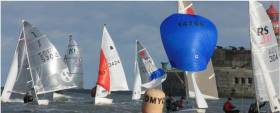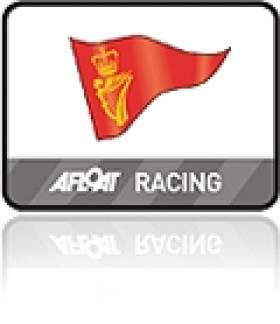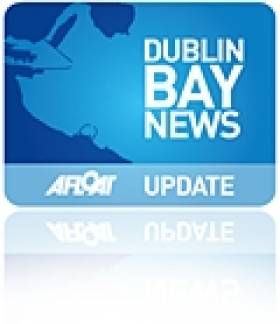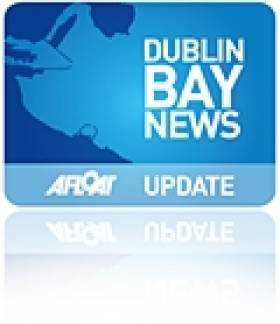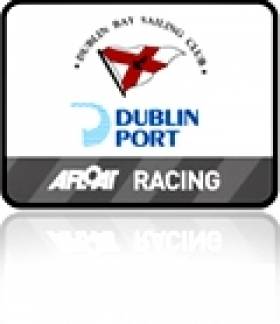Displaying items by tag: PY
Round Ireland’s Eye - Howth Lasers & Others Hop Through Weather Window From Winter To Summer
After a week of intimidating forecasts threatened the hosting of the annual Howth YC Round the Island race sponsored by Key Capital, writes Neil Murphy, Saturday, March 12th delivered a welcome morning weather window of warm sunlight and a nice sailing breeze, although the big winds promised for the afternoon were indicated by a clear blue sky to the east contrasting with increasing greyness overhead to the west. The 43 boats entered, with a Portsmouth Yardstick fleet competing for the first time, took to the water to enjoy a ‘warm-up’ race before the main event produced a high speed spin around the Island under still-blue skies.
 The clear blue sky to the eastward beyond Ian & Judith Malcolm’s 1915-vintage Water Wag Barbara………..
The clear blue sky to the eastward beyond Ian & Judith Malcolm’s 1915-vintage Water Wag Barbara………..
 ……..contrasted with the ominously greying sky to the west.
……..contrasted with the ominously greying sky to the west.
The Round Ireland’s Eye Race is the traditional conclusion to the HYC Laser Frostbite Series, now closing in on its 50th anniversary this Autumn. Over that time, the names of the sailors have changed and Lasers are now titled ILCAs, but the racers’ enthusiasm for the challenges of winter dinghy sailing remains a constant. For the first time, 2022 saw an invite being issued to the broader dinghy sailing fraternity to compete in a PY handicap event and not alone test their racing skills but their ability to assess the likely wind and tide implications of a clockwise or anti-clockwise rounding of the island.
 “We’ve been at it all winter” - ILCAs going about their business. Photo: Harry Gallagher
“We’ve been at it all winter” - ILCAs going about their business. Photo: Harry Gallagher
Despite the weather threat in the lead-up, 16 boats of various types took up the PY offer to provide a Boat Show Afloat with the Class entry list including some high tech modern racing dinghies such as RS Aeros (both 5 and 7 rigs), RS 600 and RS 800, the 1950s and ’60s era GP14, and 420 Classes along with a Water Wag and six IDRA 14s representing the more traditional clinker-built (or lapstrake-moulded) end of the dinghy racing spectrum.
A wide range of Clubs in PY was represented with Greystones, National YC, RStGYC, Skerries SC and Malahide YC figuring, while Clontarf’s six strong IDRA 14 fleet, along with their Laser entries, provided the biggest representation from a visiting Club. The Laser fleet also saw a turnout from around the country with boats from Monkstown Bay, Royal Cork, Rush, Lough Ree, Wexford Harbour and Blessington joining the home fleet.
 “A Boat Show Afloat” – it’s not often that you’ll see a Water Wag and IDRA 14s sharing a starting line with an RS Aero. Photo: Harry Gallagher
“A Boat Show Afloat” – it’s not often that you’ll see a Water Wag and IDRA 14s sharing a starting line with an RS Aero. Photo: Harry Gallagher
The event format is simple - a short Windward Leeward Race to get the competitors afloat and finalising their race strategy for the ‘big one’, followed by the RTI itself. The 6 – 8 knot breeze that welcomed the fleet to Howth Sound belied the 18 - 23 knot southerly on the forecasts but, with the opening act completed and the wind starting to prove the forecast correct, the Round the Island was ready for the off by 11.45. The course layout sees the boats race to a windward mark and then back downwind to a turning mark that this year, given the wind direction, had to be left to starboard. Arrival at the turning mark is final decision time for skippers – am I committed to the direction I decided on earlier, is there someone I want to follow or have I made a mess of the race so far and it’s time to do something different from the majority?
 Another decision….D.Kirwan of Malahide choosing the offshore route as he rounds the island’s northeast corner at The Stack. Photo: Paddy Judge
Another decision….D.Kirwan of Malahide choosing the offshore route as he rounds the island’s northeast corner at The Stack. Photo: Paddy Judge
The 15 boat PY Class was first away, followed by the 14 ILCA 7s (formerly Standard) rigs, while the ILCA 5s and 4s shared the third start. By now the breeze was hovering in the high teens and gusty and, despite Low Water not being for another 75 minutes, the tide had already started to flood north, upsetting some of the strategic decisions. Only four boats decided to chance a clockwise rounding and before they had even reached the Stack at the north east corner of the Island, less than half-way around, they were already resigned to 2023 being their next chance of success.
 Close under the cliffs the Water Wag and an IDRA 14 find williwaws every which way………….Photo: Paddy Judge
Close under the cliffs the Water Wag and an IDRA 14 find williwaws every which way………….Photo: Paddy Judge
 ……while the newest IDRA 14 – communally built in CY & BC – seems to find the island’s cliffs overbearing after the wide open spaces of her home waters. Photo: Paddy Judge
……while the newest IDRA 14 – communally built in CY & BC – seems to find the island’s cliffs overbearing after the wide open spaces of her home waters. Photo: Paddy Judge
In the anti-clockwise fleet, the RS800 of Mike Evans and Shane Hughes (HYC) streaked away but the broad reach up the east of the Island in the left-over sea from the week’s gales saw them horizontal a few times - not a good move for the scratch boat in a handicap fleet. Capsizes were frequent along the east side of the Island as the fleet broad reached on the gusty breeze, now occasionally hitting 23 knots, but the support craft were on standby to assist and only one boat needed help to return to the harbour. The Water Wag of Ian and Judith Malcolm (NYC/HYC), built in 1915 and sailing in its now-unaccustomed environment of the open sea and sizeable waves, was going well amongst its more youthful timber and GRP opposition.
 Veteran Water Wag Barbara among some ILCAs in a real hint of Spring.
Veteran Water Wag Barbara among some ILCAs in a real hint of Spring.
The ILCA 7s saw a ding-dong battle along the north side of the island as the pathfinder group in the Class, Ronan Wallace (WHBTC), Ronan Kenneally (MBSC), Dan O’Connell (ISA) and Conor Murphy (HYC), tested their decisions on how close to go the lee of the cliffs, the best course to allow the shortest distance to be sailed and how to maximise the advantage from the tide.
After a relatively quick race, helped by the freshening southerly breeze and the flooding tide, the first boat to finish was the twin-trapeze RS 800, which completed the course in 30 minutes and 18 seconds. However, with a PY number of 820 and racing against boats with as high a number as 1281, it would need a big winning margin to get to the top of the list of corrected times.
 The Line Honours winning RS 800 (Mike Evans & Shane Hughes). Photo: Paddy Judge
The Line Honours winning RS 800 (Mike Evans & Shane Hughes). Photo: Paddy Judge
After a great day of sailing providing the top quality racing around the beautiful coast of a spectacular island that the sailors came to enjoy, they came ashore for lunch in HYC followed by the Ireland England rugby match and the prizegiving – happy faces all round. The winners in the ILCA Classes were ILCA 7 – Conor Murphy (HYC), ILCA 5 – Peter Hassett (DBSC) and ILCA 4 – Fiachra Farrelly (HYC).
After the computer had done its stuff, the winner of the PY Class on corrected time saw the Aeros take the top three spots, Roy van Maanen (Greystones SC) first in a 5 rig, just ahead of Daragh Sheridan (HYC) in a 7 with Sarah Dwyer (RStGYC) third in her 5 and pipping the Malcolm’s Water Wag by just 2 seconds. First of the IDRA 14s in the PY Class was Finlay McDonald of Clontarf Y&BC.
 Daragh Sheridan’s Aero 7 took second in the PY Class. Photo: Harry Gallagher
Daragh Sheridan’s Aero 7 took second in the PY Class. Photo: Harry Gallagher
With winter sailing for the HYC dinghy fleet now completed, the next HYC Open Dinghy Event is the long-running Brassed Off Cup on Good Friday, so named because the young participants were originally those peeved at not being invited onto the team for the Easter Optimist Regatta on Lake Braassermeer in the Netherlands many years ago. Nowadays the Brassed Off Cup is the early season ‘must-do’ for juniors in the Dublin area and will be held this year on April 15th, and meanwhile, in the Fingal area on St Patrick’s Day, Malahide YC is hosting an all-comers dinghy regatta, so the new season is properly upon us.
Laser & Two PY Fleets for DMYC's Dinghy Frostbite Series
Dun Laoghaire Motor Yacht Club (DMYC) starts its 47th Season of dinghy frostbite racing in Dun Laoghaire Harbour this Sunday with a warning signal at 01.57 hrs.
The series is open to monohull centre board dinghies and attracts entries from clubs in the greater Leinster area.
The Winter 2016 series saw 19 races over the period November to the end of March. Organiser Neil Colin of the DMYC says the popular series 'offers great value for money, and with the discard system in the results, eases the pressure to turn up every week'.
In response to the changing dynamic of the entrants, with exception of the Lasers, the balance of the fleet will race in two PY fleets with the cut off set at 1068 between fleet 1 & 2, as further detailed in the Sailing Instructions.
Daily “Mug” prizes will be presented after racing in the DMYC, with soup and refreshments available along with the post race chatter.
The DMYC have limited dinghy parking for visiting entries on a “first come” basis. Full details are available here. Download the poster below.
Laser Ace Séafra Guilfoyle wins Royal Cork PY 500
#py500 – Séafra Guilfoyle has won the Royal Cork Yacht Club's PY 500 dinghy prize this afternoon. Only 8 seconds separated 3 dinghy classes at the finish writes Claire Bateman.
Saturday March 14 was the due date for the second annual PY 500 race at the Royal Cork Yacht Club. Well, what a story. The morning dawned with a beautiful blue sky and wonderful reflections in the clear water but alas and alack not a hint of a breeze could be felt and Race Officer Nathan Kirwan had no option but to postpone racing. As the race was to be held in the river, it was hoped to have a start an hour before high water but it was not to be. 'Experts' scanned the skies and ascertained that what clouds were there were moving slightly from the east. And so, when the light fickle breeze did fill in at 11.45am a windward/leeward course was set starting from the club marina with instructions for all boats to sail three rounds.
With a prize fund of €500 for the lucky winner and the ebb tide starting to flow more strongly the competitors were somewhat over eager and a general recall was necessary for the first start but all boats got away cleanly on the second attempt. The race had attracted an excellent entry of 38 but with the light wind morning this was whittled down to 32, still an excellent number. There was a great variety of craft on the water heading for the first mark ranging from National 18's, RS 400's, Lasers full rig, Laser Radials and Lasers 4.7, Toppers, an International 14, a 29er, a Pico, a Laser Stratos, a Finn and a brave Mirror and they all rounded the first mark without any incidents. They completed three rounds of the course and great concentration was needed in the light wind sailing but it proved to be a very enjoyable event resulting in only minor shouting between the competitors
When the results were calculated using the Portsmouth Yardstick only eight seconds separated the first three boats and indeed only three seconds separated the first two boats. Séafre Guilfoyle in a Laser full rig was the popular winner followed by a National 18 sailed by Nicholas O'Leary crewed by Michael O'Brien and Alex O'Connell, in second place and David Kenefick crewed by Grattan Roberts in an RS400 third .
Given the tightness of the results, one wonders what would have been the final placings if the two leading National 18's hadn't decide to concentrate between themselves on having a luffing match approaching the leeward mark in round 2, and who can tell whether or not this was where the vital three seconds between first and second place was lost. Neither they nor we will ever know for sure!
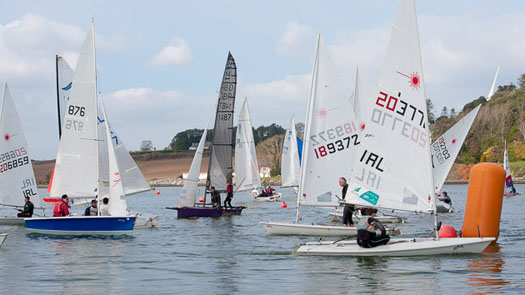
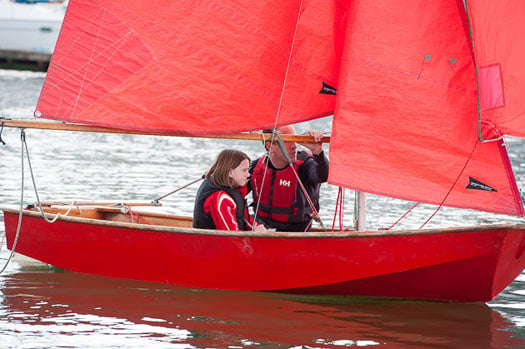
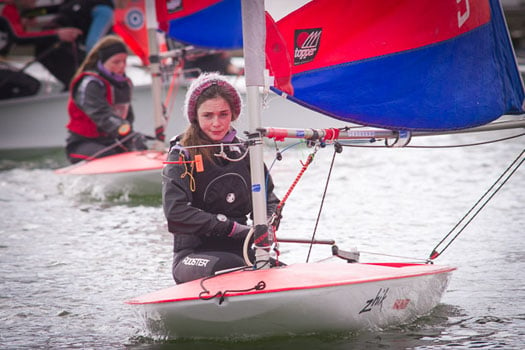
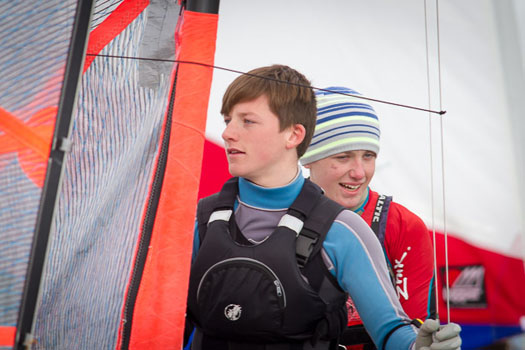
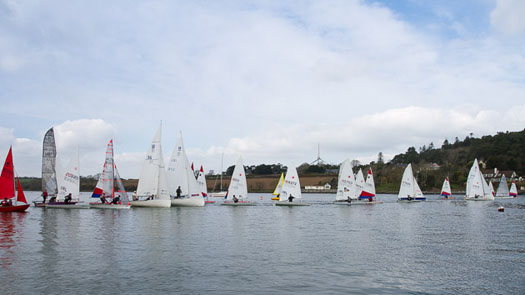
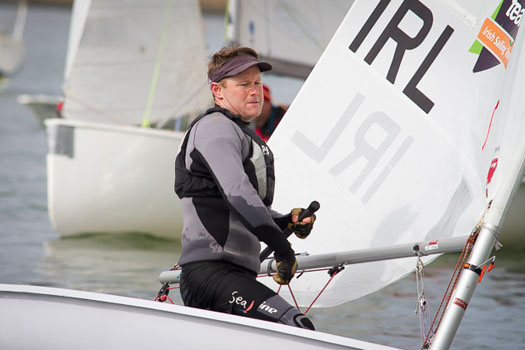
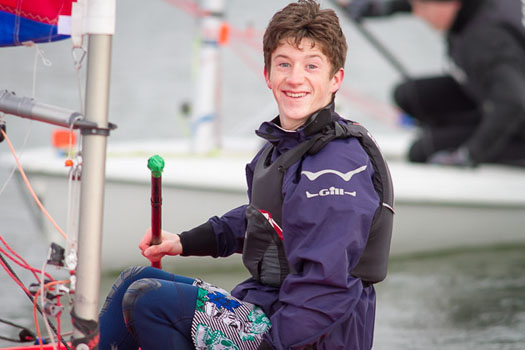
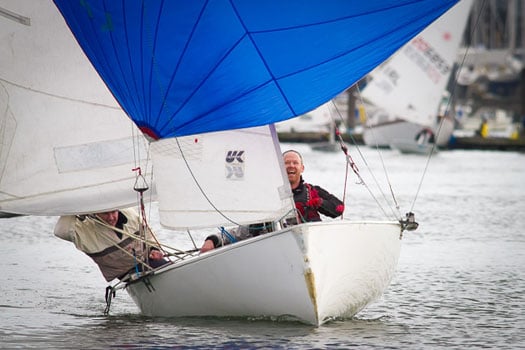
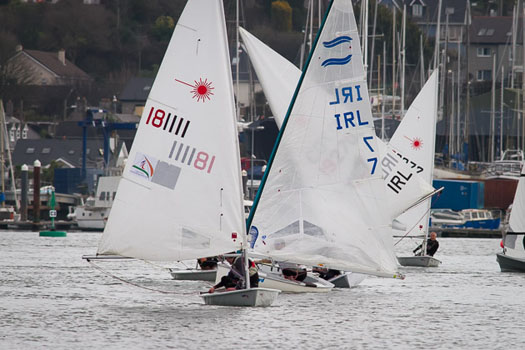
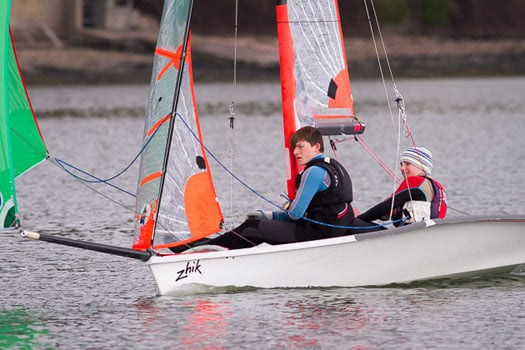
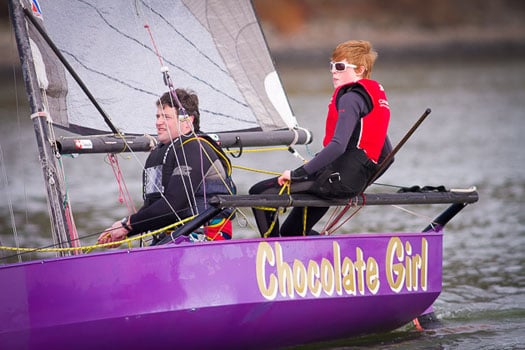
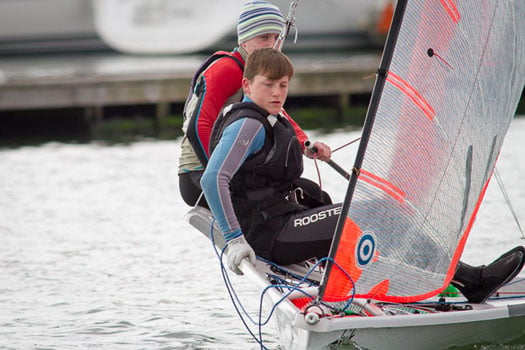
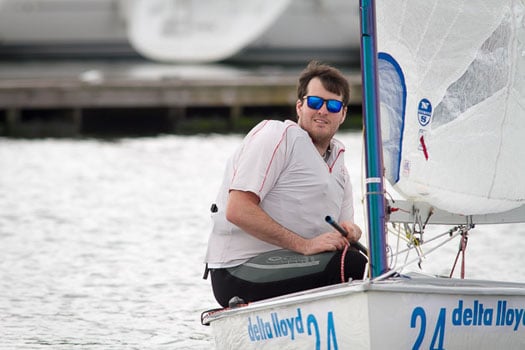
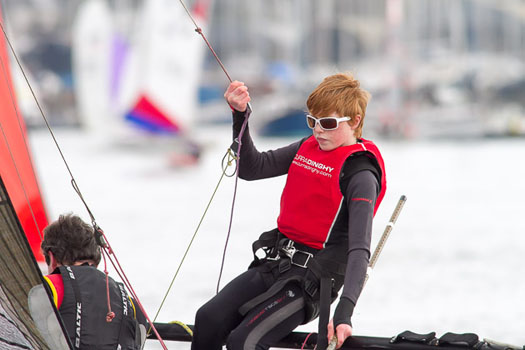

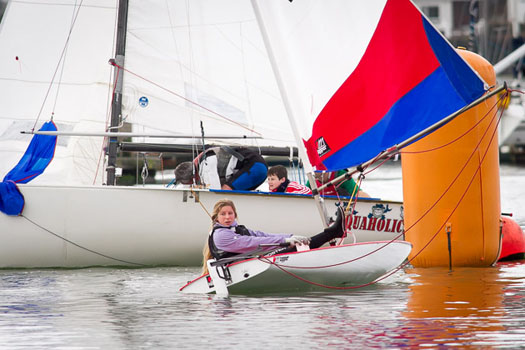
Big PY Dinghy Fleet on a Chilly Day for DMYC Frostbite
#pyfleet – The PY fleet turned out in good numbers for yesterday's DMYC frostbite series and despite the weather had a great day's racing after all writes Hugh Sheehy. Cold water temperatures and winds gusting from 10 knots to 28 knots led to some conservative sailing, but the racing was still pretty full on.
At the end the result continued the recent strong run by the Finns, with Richard Tate leading the way home from Long and Hamilton in the IDRA14s.
Tate started with the main group down at the pin while Des Fortune's Finn timed a gust right and got a big right shift off the boat end right at the gun. Fortune's boat was clearly ahead at the first mark with Tate and Long chasing hard back in from the left. It was PUFFY under the weather mark.
Careful sailing was the order of business down the run with booms not let too far out and some spinnakers not-flying. Tate and Fortune's Finns started to pull clear on the 2nd beat before Fortune's boat retired leaving Tate to sail out to victory. A nice win, although not by a big margin, with Long only 20 seconds behind on corrected time. And although Hamilton was a full two minutes further back he only had ten seconds over Tom Murphy in the K1.
The most notable result was the one second difference between Devaney and Lordan in 5th and 6th. Tight times!
PY and Laser fleets each had 13 boats on the water, with the RS and Fireball fleets disappointed to see only 5 boats in each class. But it was a good day.
A good day! And a good day to have a good wetsuit too!
DMYC PY Fleet Is Dead Heat at the Top
#dmyc – With only ten boats on the water there was a little more room than usual on the start line in Race 1, which Sheehy's OK Dinghy took advantage of with a clean pin end start, tacking and crossing the fleet. Half way up the first beat the lead had gone. Results for both races are downloadable below.
Pierre Long had picked a good left shift and was coming across on port in his IDRA14. He had caught right up but only saw the now starboard tack OK Dinghy at the last moment. A slam tack resulted in an extremely unwanted capsize, mere minutes after the start. Ouch.
Frank Hamilton took advantage and sailed out to another race win with Des Fortune's Finn - ably sailed by Colin Galavan - only 40 seconds behind in 2nd. With discards kicking in the Finn and Hamilton's IDRA14 ended the race 1st and 2nd, and joint first overall. Meantime Long had righted the capsized IDRA and fought back to finish 7th!
In Race 2 the start was marred by a windward/leeward between Long's IDRA and Sheehy's OK Dinghy in the seconds before the gun. The OK Dinghy's protest will be heard next week. McCarthy won the start this time, with another clean tack and cross just after the gun showing excellent timing.
In the race itself, McCarthy's Solo sailed off to a solid win, with Galavan taking Des Fortune's Finn to another second place. Long was 3rd (pending protest) with Hamilton unusually far back in 4th.
As in the Laser race there were gains in the corners - but big losses too. In race 1 Hamilton threaded his way through every shift correctly and was clearly the fastest boat out there. In race 2 McCarthy did the same, avoiding big losses and sailing fast and clean to the win.
Moderate easterly winds produced a great night's sailing on Dublin Bay tonight for the second Tuesday night race of the DBSC Summer season. In the Fireball dinghy class S. Oram's unnamed boat entry won again from Louis Smyth's 'Licence to Thrill'. Gary O'Hare lead the Laser fleet and picked up the Portsmouth Yardstick (PY) win from P. Keane. Third on PY was E. Ryan's RS400 dinghy.
DUBLIN PORT Dublin Bay Sailing Club Results for 3 MAY 2011
IDRA 14 FOOT - 1. Dunmoanin (Frank Hamilton)
MERMAID - 1. Jill (P.Smith/P.Mangan), 2. Lively Lady (G O'Neill & M Hanney)
PY CLASS - 1. Gary O'Hare (Laser), 2. P Keane (Laser 1), 3. E Ryan (RS400)
CRUISERS 2 - 1. Graduate (D O'Keeffe), 2. Cor Baby (Keith Kiernan et al)
CRUISERS 3 - 1. Papytoo (M.Walsh/F.Guilfoyle), 2. Chouskikou (R.Sheehan/R.Hickey), 3. Grasshopper 2 (K & J Glynn)
CRUISERS 4 - 1. Ghrazel (Charles Pearson), 2. Maranda (Myles Kelly)
FIREBALL - 1. nn (S Oram), 2. Licence to Thrill (Louis Smyth), 3. Elevation (N.Colin/M.Casey)
GLEN - 1. Glendun (B.Denham et al), 2. Glenshesk (L.Faulkner et al), 3. Glenshane (P Hogan)
RUFFIAN 23 - 1. Icicle (C & J Murray), 2. Diane ll (Bruce Carswell), 3. Alias (D.Meeke/M.McCarthy)




























